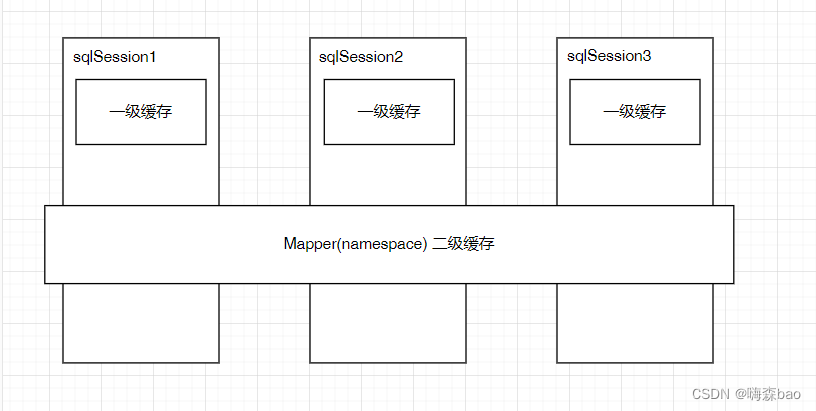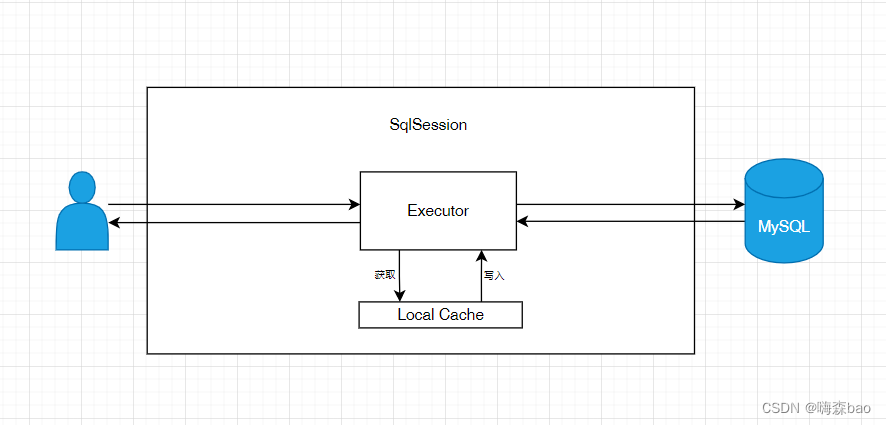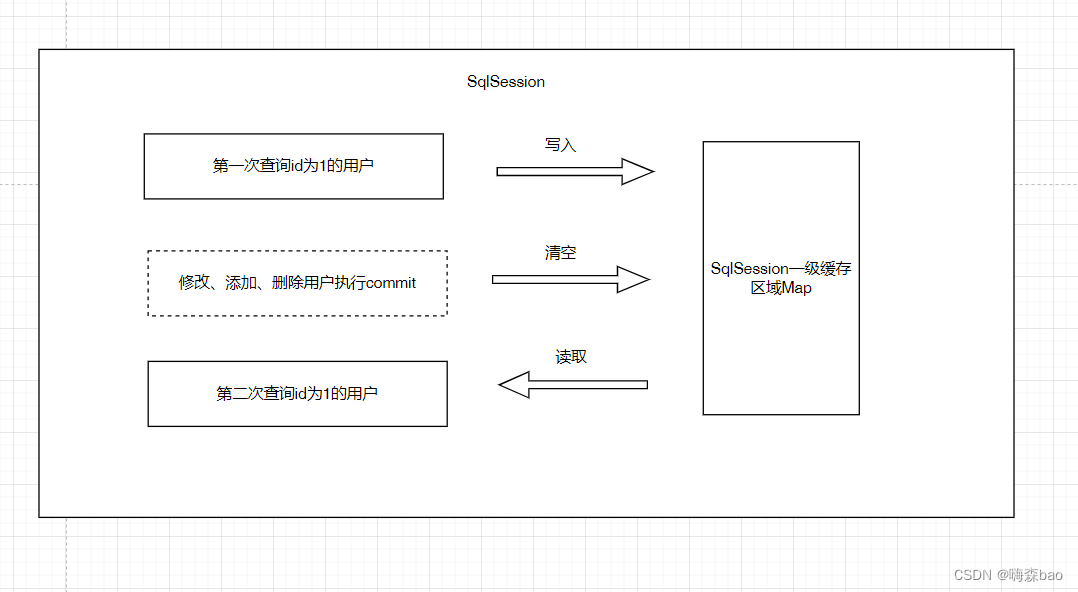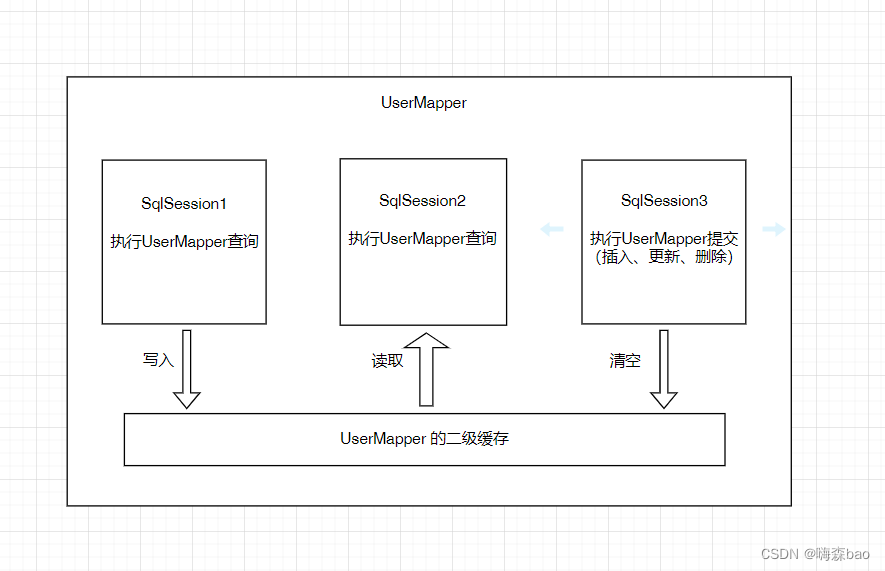-
【Myatis】mybatis的缓存机制
1、mybatis的代理详解
Java中动态代理主要是JDK动态代理(接口),CGLib动态代理(类继承)
SqlSession sqlSession = sqlSessionFactory.openSession(); /** *在通过sqlSession.getMapper可以获取一个代理对象 * 对于StudentMapper并没有显性的实现该接口的实现类, * 该对象是在运行时动态产生的,该对象就是动态代理对象 * * JDK动态代理 * 1、首先存在接口(StudentMapper.java) * 2、必须存在该接口的实现类(sqlSession.selectOne) * 3、实现invocationHandler辅助类 * 4、通过Proxy类来产生代理对象 */ //单个对象原始调用方式 // Student student = sqlSession.selectOne("com.tulun.Mybatis.mapper.StudentMapper.selectStudentById", 4); StudentMapper studentMapper = sqlSession.getMapper(StudentMapper.class); Student student = studentMapper.selectStudentById(4); System.out.println(student);- 1
- 2
- 3
- 4
- 5
- 6
- 7
- 8
- 9
- 10
- 11
- 12
- 13
- 14
- 15
- 16
- 17
- 18
- 19
- 20
mybatis是否用到了JDK动态代理相关的接口和类?产生代理对象如何组织?
mybatis中代理对象的获取是通过如下方法:
sqlSession.getMapper(StudentMapper.class);- 1
mapper接口是如何添加进去的?
通过Java代码形式来进行数据源、映射文件的配置形式如下:Configuration configuration = new Configuration(); PooledDataSourceFactory dataSourceFactory = new PooledDataSourceFactory(); DataSource dataSource = dataSourceFactory.getDataSource(); JdbcTransactionFactory jdbcTransactionFactory = new JdbcTransactionFactory(); //设置环境 Environment environment = new Environment("test", jdbcTransactionFactory, dataSource); configuration.setEnvironment(environment); //设置mapper接口 configuration.addMapper(StudentMapper.class); new SqlSessionFactoryBuilder().build(configuration);- 1
- 2
- 3
- 4
- 5
- 6
- 7
- 8
- 9
- 10
- 11
重点在于接口的添加形式:
configuration.addMapper(StudentMapper.class);- 1
在Configuration类中:
public <T> void addMapper(Class<T> type) { mapperRegistry.addMapper(type); }- 1
- 2
- 3
mapper在Configuration类中没有做任何事,只是添加到mapperRegistry类中。
public <T> void addMapper(Class<T> type) { if (type.isInterface()) {//只允许添加接口 if (hasMapper(type)) {//不允许重复添加 throw new BindingException("Type " + type + " is already known to the MapperRegistry."); } boolean loadCompleted = false; try { knownMappers.put(type, new MapperProxyFactory<T>(type)); MapperAnnotationBuilder parser = new MapperAnnotationBuilder(config, type); parser.parse(); loadCompleted = true; } finally { if (!loadCompleted) { knownMappers.remove(type); } } } }- 1
- 2
- 3
- 4
- 5
- 6
- 7
- 8
- 9
- 10
- 11
- 12
- 13
- 14
- 15
- 16
- 17
- 18
执行的configuration.addMapper(StudentMapper.class),实际上最终被放入HashMap中,其命名knownMappers,它是mapperRegistry类中的私有属性,是一个HashMap对象,key是接口class对象,value是MapperProxyFactory的对象实例。
通过getMapper获取代理对象。
DefaultSqlSession类:public <T> T getMapper(Class<T> type) { return configuration.<T>getMapper(type, this); }- 1
- 2
- 3
configuration类中存放所有的mybatis全局配置信息,从参数上可以知道class类型。
configuration类:public <T> T getMapper(Class<T> type, SqlSession sqlSession) { return mapperRegistry.getMapper(type, sqlSession); }- 1
- 2
- 3
configuration类中getmapper调用了mapperRegistry.getMapper,mapperRegistry中存放一个HashMap
。
mapperRegistry类:private final Map<Class<?>, MapperProxyFactory<?>> knownMappers = new HashMap<Class<?>, MapperProxyFactory<?>>(); public <T> T getMapper(Class<T> type, SqlSession sqlSession) { final MapperProxyFactory<T> mapperProxyFactory = (MapperProxyFactory<T>) knownMappers.get(type); if (mapperProxyFactory == null) { throw new BindingException("Type " + type + " is not known to the MapperRegistry."); } try { return mapperProxyFactory.newInstance(sqlSession); } catch (Exception e) { throw new BindingException("Error getting mapper instance. Cause: " + e, e); } }- 1
- 2
- 3
- 4
- 5
- 6
- 7
- 8
- 9
- 10
- 11
- 12
- 13
- 14
调用mapperRegistry类中的getMapper方法,该方法中会到hashmap中通过类名获取对应的value值,是MapperProxyFactory对象,然后调用newInstance方法,该方法是创建了一个对象。
public class MapperProxyFactory<T> {//映射器代理工厂 private final Class<T> mapperInterface; private final Map<Method, MapperMethod> methodCache = new ConcurrentHashMap<Method, MapperMethod>(); @SuppressWarnings("unchecked") protected T newInstance(MapperProxy<T> mapperProxy) { //使用的是JDK自带的动态代理对象生成代理类对象 return (T) Proxy.newProxyInstance(mapperInterface.getClassLoader(), new Class[] { mapperInterface }, mapperProxy); } public T newInstance(SqlSession sqlSession) { final MapperProxy<T> mapperProxy = new MapperProxy<T>(sqlSession, mapperInterface, methodCache); return newInstance(mapperProxy); } }- 1
- 2
- 3
- 4
- 5
- 6
- 7
- 8
- 9
- 10
- 11
- 12
- 13
- 14
- 15
- 16
- 17
public class MapperProxy<T> implements InvocationHandler, Serializable { //实现了InvocationHandler接口 @Override //代理之后,所有的mapper的方法调用,都会调用这个invoke方法 @Override public Object invoke(Object proxy, Method method, Object[] args) throws Throwable { try { if (Object.class.equals(method.getDeclaringClass())) { return method.invoke(this, args); } else if (method.isDefault()) { return invokeDefaultMethod(proxy, method, args); } } catch (Throwable t) { throw ExceptionUtil.unwrapThrowable(t); } final MapperMethod mapperMethod = cachedMapperMethod(method); return mapperMethod.execute(sqlSession, args); } }- 1
- 2
- 3
- 4
- 5
- 6
- 7
- 8
- 9
- 10
- 11
- 12
- 13
- 14
- 15
- 16
- 17
- 18
- 19
- 20
- 21
- 22
mybatis中getmapper的代理对象的获取,使用的是JDK动态代理,在MapperRegistry类中的HashMap中存放了所有的mapper接口,key是接口的类名信息,value是MapperProxyFactory类型实例,getmapper操作会是当前对象调用newInstance操作,该操作会调用Proxy.newProxyInstance核心在于调用InvocationHandler接口,实现了invoke方法,除了调用原始的接口调用,而且还对调用进行增强,进行了方法缓存,且最终会执行增删改查操作。
总结Mapper接口方法执行的几个点:
- Mapper接口初始在SQLSessionFactory注册的。
- Mapper接口注册在MapperRegistry类的HashMap中,key是mapper的接口类名,value是创建当前代理工厂。
- Mapper注册之后,可以从过SQLSession来获取get对象。
- SQLSession.getMapper运用了JDK动态代理,产生了目标Mapper接口的代理对象,动态代理的代理类是MapperProxy,实现了增删改查调用。
2、mybatis的缓存机制
2.1、缓存介绍
mybatis中提供查询缓存,用于减轻数据库的压力,提高数据库的性能。
mybatis提了了一级缓存和二级缓存:

一级缓存是SQLSession级别缓存,在操作数据库时都需要构造SQLSession对象,在对象中有一个数据结构(HashMap)用于存储缓存数据,不同的SQLSession之间的缓存数据区域是互不影响的。
一级缓存的作用于是在同一个SQLSession,在同一个SQLSession中执行相同的两次SQL,第一次执行完毕在后会将数据写到缓存中,第二次从缓存中进行后去就不在数据库中查询,从而提高了效率,
当一个SQLSession结束后该SQLSession中的一级缓存也就不存在了,mybatis默认开启一级缓存。二级缓存是mapper级别缓存,多个SQLSession去操作同一个mapper的SQL语句,多个SQLSession操作都会存在二级缓存中,多个SQLSession共用二级缓存,二级缓存是跨SQLSession的。
二级缓存是多个SQLSession共享的,作用域是mapper下的同一个namespace。不同的SQLSession两次执行相同的namespace下的SQL最终能获取相同的SQL语句结果。
mybatis默认是没有开启二级缓存的,需要在全局配置文件中配置开启二级缓存。2.2、一级缓存
一级缓存介绍

每个SqlSession中持有一个执行器Executor,每个执行器中有一个Local Cache,当用户发起查询时,mybatis根据当前执行的语句生成mapperStatement,在Local Cache中进行查询,如果缓存命中的话,直接返回给用户,如果没有命中,查询数据库,结果写入Local Cache中,最后返回给用户。
通过ID查询用户信息:

缓存生效失效时机:
如果是连续的查询同一个数据操作,在第一次查询之后,后续查询都可以命中缓存。
如果在查询之后,紧接着是进行变更操作,就会导致缓存失效。一级缓存测试
mybatis是默认支持一级缓存,不需要做其他配置。
测试1:同一个SQLSession下连续进行查询操作:
//同一个SQLSession连续进行查询操作 StudentMapper studentMapper = sqlSession.getMapper(StudentMapper.class); //第一次查询操作 System.out.println("第一次查询开始......"); Student student = studentMapper.selectStudentById(4); System.out.println("第一次查询结束......"); System.out.println("第二次查询开始......"); Student student1 = studentMapper.selectStudentById(4); System.out.println("第二次查询结束......");- 1
- 2
- 3
- 4
- 5
- 6
- 7
- 8
- 9
- 10
- 11
- 12
通过执行结果可知:第一次查询会查询数据库,第二次查询操作是没有查询SQL,即通过缓存查询到结果返回。
测试2:第一次查询结束后,对数据进行变更操作,再次执行查询操作:
//同一个SQLSession连续进行查询操作 StudentMapper studentMapper = sqlSession.getMapper(StudentMapper.class); //第一次查询操作 System.out.println("第一次查询开始......"); Student student = studentMapper.selectStudentById(4); System.out.println("第一次查询结束......"); //对数据进行变更操作 System.out.println("变更操作开始...."); studentMapper.updateNameById(4,"test"); sqlSession.commit(); System.out.println("变更操作结束...."); //第二次查询 System.out.println("第二次查询开始......"); Student student1 = studentMapper.selectStudentById(4); System.out.println("第二次查询结束......");- 1
- 2
- 3
- 4
- 5
- 6
- 7
- 8
- 9
- 10
- 11
- 12
- 13
- 14
- 15
- 16
- 17
在查询结束后,如果对于数据进行变更操作,会删除掉缓存,导致第二次查询依然需要进入到数据库。
测试3:不同的SQLSession下同一个操作是否会命中缓存:
SqlSession sqlSession = sqlSessionFactory.openSession(); //分别数据不同的SQLSession是否会命中缓存 StudentMapper studentMapper = sqlSession.getMapper(StudentMapper.class); //第一次查询操作 System.out.println("第一次查询开始......"); Student student = studentMapper.selectStudentById(4); System.out.println("第一次查询结束......"); SqlSession sqlSession1 = sqlSessionFactory.openSession(); StudentMapper studentMapper1 = sqlSession1.getMapper(StudentMapper.class); //第二次查询 System.out.println("第二次查询开始......"); Student student1 = studentMapper1.selectStudentById(4); System.out.println("第二次查询结束......");- 1
- 2
- 3
- 4
- 5
- 6
- 7
- 8
- 9
- 10
- 11
- 12
- 13
- 14
- 15
- 16
不同的SQLSession的一级缓存是无法共享的。
2.3、二级缓存
mybatis中二级缓存是mapper级别的缓存,默认是关闭的。
对于一个mapper下的不同的SQLSession可以共享二级缓存。
不同的mapper是相互隔离的。
二级缓存的特点是需要打开二级缓存的配置,并且需要映射的java类需要实现序列化。二级缓存原理

二级缓存和一级缓存的区别:
二级缓存范围更大,多个SQLSession可以共享一个mapper级别的二级缓存,数据类型依然是HashMap来存储二级缓存内容,mapper是按照namespace划分,如果namespace相同则使用同一个二级缓存,
一级缓存范围会更小,是一个SQLSession级别。二级缓存使用步骤
第一步:在mybatis的全局配置文件中开启二级缓存:<settings> <!--cacheEnabled:开启mybatis的二级缓存--> <setting name="cacheEnabled" value=" true"/> </settings>- 1
- 2
- 3
- 4
第二步:将映射的pojo类实现序列化:
public class Student implements Serializable- 1
第三步:在mapper配置文件中使用cache标签:
<!-- cache和二级缓存相关标签 eviction属性:代表缓存的回收策略,mybatis提供了回收策略如下: LRU:最近最少使用,对于最长时间不用的对象进行回收 FIFO:先进先出,按照帝乡进入缓存的顺序来进行回收 SOFT:软引用,移除基于垃圾回收器状态和软引用规则的对象 WEAK:弱引用,基于垃圾回收器状态和弱引用规则的对象 flushInterval属性:刷新间隔时间,单位是毫秒 size属性:引用数目,代表缓存可以存储最多多少个对象 readOnly属性:只读,意味着缓存数据只能读取不能修改 --> <cache eviction="FIFO" flushInterval="1000" size="1024" readOnly="false"/>- 1
- 2
- 3
- 4
- 5
- 6
- 7
- 8
- 9
- 10
- 11
- 12
- 13
注:在select查询导致上使用属性:
useCache=“true” 缓存的使用和禁止
flushCache=“true” 刷新缓存二级缓存使用测试
//二级缓存的测试 @Test public void testCache2() { //不同的SQLSession会话进行相同的SQL查询操作 //SQLSession1实例 SqlSession sqlSession = sessionFactory.openSession(); Student23Mapper student23Mapper = sqlSession.getMapper(Student23Mapper.class); //SQLSession2实例 SqlSession sqlSession1 = sessionFactory.openSession(); Student23Mapper student23Mapper1 = sqlSession1.getMapper(Student23Mapper.class); //sqlsession实例3 SqlSession sqlSession2 = sessionFactory.openSession(); Student23Mapper student23Mapper2 = sqlSession2.getMapper(Student23Mapper.class); //第一次查询id为1的用户 Student23 student23 = student23Mapper.selectStudentByUid(1L); System.out.println(student23); //这里执行关闭操作,将SQLSession中的数据写入到二级缓存区域 sqlSession.close(); //第二次查询id为1的用户 Student23 student24 = student23Mapper1.selectStudentByUid(1L); System.out.println(student24); sqlSession1.close(); }- 1
- 2
- 3
- 4
- 5
- 6
- 7
- 8
- 9
- 10
- 11
- 12
- 13
- 14
- 15
- 16
- 17
- 18
- 19
- 20
- 21
- 22
- 23
- 24
- 25
- 26
- 27
- 28

表明不同的SQLSession可以共享一个二级缓存。
底层:二级缓存是一个Cache接口的实现类,一级缓存是一个localCache是一个HashMap的属性,
执行过程先经过二级缓存,在二级缓存未命中时才会走一级缓存。 -
相关阅读:
Linux安装Nacos
运行期获得文件名和行号
力扣225.用队列实现栈
李永乐讲卷积神经网络,李永乐老师讲人工智能
如何隐藏删除去除桌面图标快捷方式的小箭头(含恢复方法)
数据持久化层场景实战:业务场景+数据库分区+冷热分离概述
计算机毕业设计ssm扶贫产品和扶贫物资捐赠系统r32rk系统+程序+源码+lw+远程部署
整合Mybatis、Servlet、Mysql、Axios、Filter、Session写一个入门级项目:非常适合初接触JavaWeb的小白白来进阶
记一次生产慢sql索引优化及思考
javascript | 变量、函数、属性的命名规则
- 原文地址:https://blog.csdn.net/weixin_49782150/article/details/125893277
